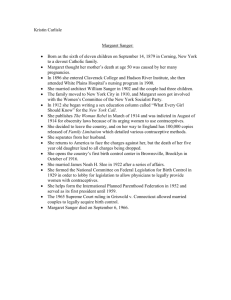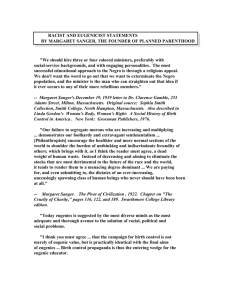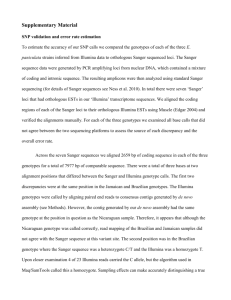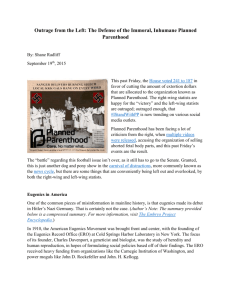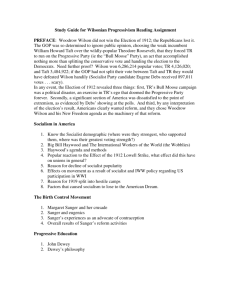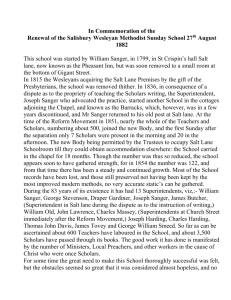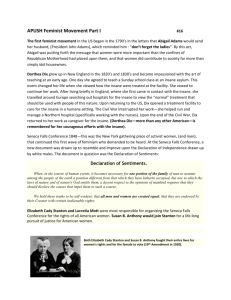Opposition Claims About Margaret Sanger
advertisement
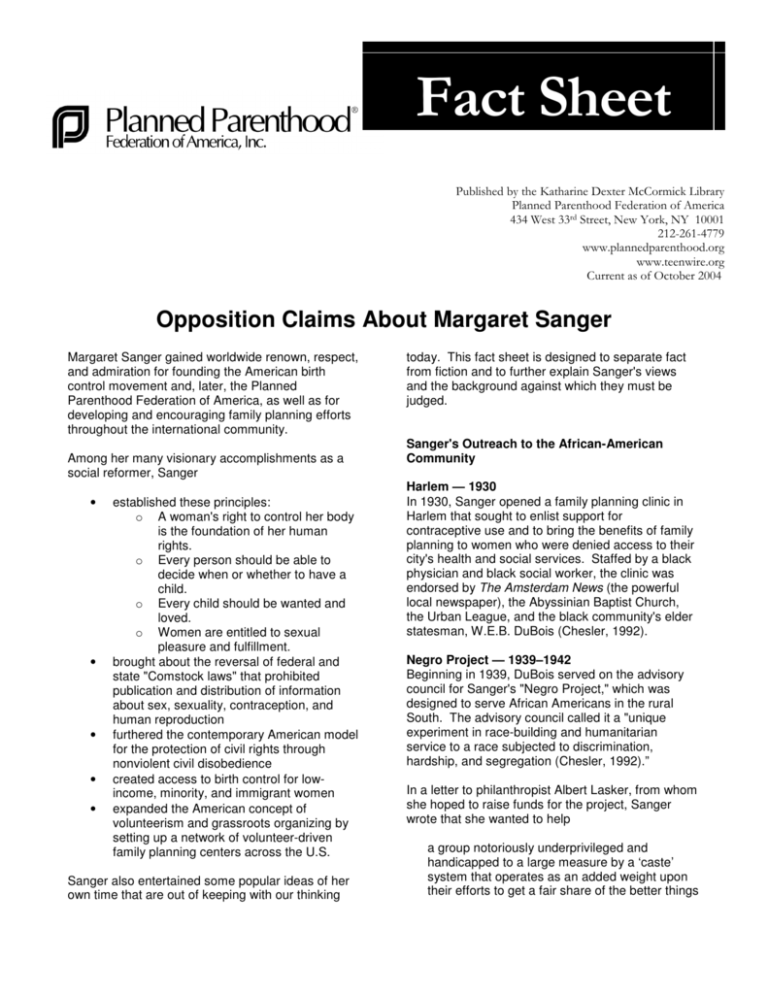
!" # $
###,
-
!"$ %&&&%
'%'(')%( **+
,.
###, # , .
/
'&&
Opposition Claims About Margaret Sanger
Margaret Sanger gained worldwide renown, respect,
and admiration for founding the American birth
control movement and, later, the Planned
Parenthood Federation of America, as well as for
developing and encouraging family planning efforts
throughout the international community.
Among her many visionary accomplishments as a
social reformer, Sanger
•
•
•
•
•
established these principles:
o A woman's right to control her body
is the foundation of her human
rights.
o Every person should be able to
decide when or whether to have a
child.
o Every child should be wanted and
loved.
o Women are entitled to sexual
pleasure and fulfillment.
brought about the reversal of federal and
state "Comstock laws" that prohibited
publication and distribution of information
about sex, sexuality, contraception, and
human reproduction
furthered the contemporary American model
for the protection of civil rights through
nonviolent civil disobedience
created access to birth control for lowincome, minority, and immigrant women
expanded the American concept of
volunteerism and grassroots organizing by
setting up a network of volunteer-driven
family planning centers across the U.S.
Sanger also entertained some popular ideas of her
own time that are out of keeping with our thinking
today. This fact sheet is designed to separate fact
from fiction and to further explain Sanger's views
and the background against which they must be
judged.
Sanger's Outreach to the African-American
Community
Harlem — 1930
In 1930, Sanger opened a family planning clinic in
Harlem that sought to enlist support for
contraceptive use and to bring the benefits of family
planning to women who were denied access to their
city's health and social services. Staffed by a black
physician and black social worker, the clinic was
endorsed by The Amsterdam News (the powerful
local newspaper), the Abyssinian Baptist Church,
the Urban League, and the black community's elder
statesman, W.E.B. DuBois (Chesler, 1992).
Negro Project — 1939–1942
Beginning in 1939, DuBois served on the advisory
council for Sanger's "Negro Project," which was
designed to serve African Americans in the rural
South. The advisory council called it a "unique
experiment in race-building and humanitarian
service to a race subjected to discrimination,
hardship, and segregation (Chesler, 1992).”
In a letter to philanthropist Albert Lasker, from whom
she hoped to raise funds for the project, Sanger
wrote that she wanted to help
a group notoriously underprivileged and
handicapped to a large measure by a ‘caste’
system that operates as an added weight upon
their efforts to get a fair share of the better things
in life. To give them the means of helping
themselves is perhaps the richest gift of all. We
believe birth control knowledge brought to this
group, is the most direct, constructive aid that
can be given them to improve their immediate
situation (Sanger, 1939, July).
In 1942, she wrote again to Lasker, saying
I think it is magnificent that we are in on the
ground floor, helping Negroes to control their
birth rate, to reduce their high infant and
maternal death rate, to maintain better standards
of health and living for those already born, and to
create better opportunities for those who will be
born (Sanger, 1942).”
Other leaders of the African-American community
who were involved in the project included Mary
McLeod Bethune, founder of the National Council of
Negro Women, and Adam Clayton Powell Jr., pastor
of the Abyssinian Baptist Church in Harlem.
The Negro Project was also endorsed by prominent
white Americans who were involved in social justice
efforts at this time, including Eleanor Roosevelt, the
most visible and compassionate supporter of racial
equality in her era; and the medical philanthropists,
Albert and Mary Lasker, whose financial support
made the project possible (Chesler, 1992).
Division of Negro Service —1940–43
Sanger’s Birth Control Federation of America, which
became Planned Parenthood Federation of
American in 1942, established a Division of Negro
Service to oversee the Negro Project and to
implement Sanger’s educational outreach to African
Americans nationally. Sponsored by Sanger’s
fundraising efforts and directed by Florence Rose,
the division provided black organizations across the
country with Planned Parenthood literature, set up
local educational exhibits, facilitated local and
national public relations, and employed an AfricanAmerican doctor, Mae McCarroll, to lobby medical
groups and teach contraceptive techniques to other
black doctors.
Martin Luther King Jr.
In 1966, the year Sanger died, the Rev. Martin
Luther King, Jr. said
There is a striking kinship between our
movement and Margaret Sanger's early efforts.
. . . Our sure beginning in the struggle for
equality by nonviolent direct action may not
have been so resolute without the tradition
established by Margaret Sanger and people like
her (King, 1966).
Was Sanger racially motivated?
Despite the admiration that African-American heroes
like DuBois, Powell, and King held for Sanger,
arguments continue about whether or not her
outreach to the black community was racially
motivated. The patriarchal racism of the social
policy of the time and the well-intentioned
paternalism of philanthropists to “lift up” AfricanAmericans, may have influenced Sanger. But there
is no evidence that Sanger, or the Federation,
intended to coerce black women into using birth
control:
The fundamental belief, underscored at every
meeting, mentioned in much of the behind-thescenes correspondence, and evident in all the
printed material put out by the Division of Negro
Service, was that uncontrolled fertility presented
the greatest burden to the poor, and Southern
blacks were among the poorest Americans. In
fact, the Negro Project did not differ very much
from the earlier birth control campaigns in the
rural South … it would have been more racist, in
Sanger’s mind, to ignore African Americans in
the South than to fail at trying to raise the health
and economic standards of their communities
(“Birth Control or Race Control,” 2001).
Sanger and Eugenics
Eugenics is a theory of improving hereditary
qualities by socially controlling human reproduction.
Eugenicists, including the Nazis, were opposed to
the use of contraception or abortion by healthy and
“fit” women (Grossmann, 1995). In fact, Sanger’s
books were among the very first burned by the Nazis
in their campaign against family planning (“Sanger
on Exhibit,” 1999/2000). (Sanger helped several
Jewish women and men and others escape the Nazi
regime in Germany (“Margaret Sanger and the
‘Refugee Department’,” 1993).)
Sanger, however, clearly identified with the broader
issues of health and fitness that concerned the early
20th-century eugenics movement, which was
enormously popular and well-respected during the
1920s and '30s — decades in which treatments for
many hereditary and disabling conditions were
unknown. But Sanger always believed that
reproductive decisions should be made on an
individual and not a social or cultural basis, and she
consistently and firmly repudiated any racial
application of eugenics principles. For example,
Sanger vocally opposed the racial stereotyping that
effected passage of the Immigration Act of 1924, on
the grounds that intelligence and other inherited
traits vary by individual and not by group (Chesler,
1992).
because its early 20th-century founder was not a
perfect model of early 21st-century values is like
disavowing the Declaration of Independence
because its author, Thomas Jefferson, bought and
sold slaves.
Though she tried for years, Sanger was unable to
convince the leaders of the eugenics movement to
accept her credo that “No woman can be free who
does not own and control her body (Sanger, 1920).”
Her on-going disagreement with the eugenicists of
her day is clear from her remarks in The Birth
Control Review of February 1919:
Published Statements that Distort or Misquote
Margaret Sanger
Eugenists imply or insist that a woman's first
duty is to the state; we contend that her duty
to herself is her first duty to the state. We
maintain that a woman possessing an
adequate knowledge of her reproductive
functions is the best judge of the time and
conditions under which her child should be
brought into the world. We further maintain
that it is her right, regardless of all other
considerations, to determine whether she
shall bear children or not, and how many
children she shall bear if she chooses to
become a mother. … Only upon a free, selfdetermining motherhood can rest any
unshakable structure of racial betterment
(Sanger, 1919a).
Although Sanger uniformly repudiated the racist
exploitation of eugenics principles, she agreed with
the "progressives" of her day who favored
•
•
•
incentives for the voluntary hospitalization
and/or sterilization of people with
untreatable, disabling, hereditary conditions
the adoption and enforcement of stringent
regulations to prevent the immigration of the
diseased and "feebleminded" into the U.S.
placing so-called illiterates, paupers,
unemployables, criminals, prostitutes, and
dope-fiends on farms and open spaces as
long as necessary for the strengthening and
development of moral conduct
Planned Parenthood Federation of America finds
these views objectionable and outmoded.
Nevertheless, anti-family planning activists continue
to attack Sanger, who has been dead for nearly 40
years, because she is an easier target than the
unassailable reputation of PPFA and the
contemporary family planning movement. However,
attempts to discredit the family planning movement
Through the years, a number of alleged Sanger
quotations, or allegations about her, have surfaced
with regularity in anti-family planning publications:
“More children from the fit, less from the unfit —
that is the chief issue in birth control.”
A quotation falsely attributed to Margaret Sanger,
this statement was made by the editors of American
Medicine in a review of an article by Sanger. The
editorial from which this appeared, as well as
Sanger's article, "Why Not Birth Control Clinics in
America?" were reprinted side-by-side in the May
1919 Birth Control Review (Sanger, 1919b).
“The mass of ignorant Negroes still breed
carelessly and disastrously, so that the increase
among Negroes, even more than the increase
among whites, is from that portion of the
population least intelligent and fit, and least able
to rear their children properly.”
Another quotation falsely attributed to Margaret
Sanger, this was actually written for the June 1932
issue of The Birth Control Review by W.E.B. DuBois,
founder of the National Association for the
Advancement of Colored People (NAACP). Taken
out of the context of his discussion about the effects
of birth control on the balance between quality-of-life
considerations and race-survival issues for AfricanAmericans, Dubois' language seems insensitive by
today's standards.
“Blacks, soldiers, and Jews are a menace to the
race.”
This fabricated quotation, falsely attributed to
Sanger, was concocted in the late 1980s. The
alleged source is the April 1933 Birth Control Review
(Sanger ceased editing the Review in 1929). That
issue contains no article or letter by Sanger.
“To create a race of thoroughbreds . . .”
This remark, again attributed originally to Sanger,
was made by Dr. Edward A. Kempf and has been
cited out of context and with distorted meaning. Dr.
Kempf, a progressive physician, was actually
arguing for state endowment of maternal and infant
care clinics. In her book The Pivot of Civilization,
Sanger quoted Dr. Kempf's argument about how
environment may improve human excellence:
Society must make life worth the living and
the refining for the individual by conditioning
him to love and to seek the love-object in a
manner that reflects a constructive effect
upon his fellow-men and by giving him
suitable opportunities. The virility of the
automatic apparatus is destroyed by
excessive gormandizing or hunger, by
excessive wealth or poverty, by excessive
work or idleness, by sexual abuse or
intolerant prudishness. The noblest and
most difficult art of all is the raising of human
thoroughbreds (Sanger, 1922 [1969]).
It was in this spirit that Sanger used the phrase,
"Birth Control: To Create a Race of
Thoroughbreds," as a banner on the November
1921 issue of the Birth Control Review. (Differing
slogans on the theme of voluntary family planning
sometimes appeared under the title of The Review,
e.g., "Dedicated to the Cause of Voluntary
Motherhood," January 1928.)
“The most merciful thing that the large family
does to one of its infant members is to kill it.”
This statement is taken out of context from Margaret
Sanger's Woman and the New Race (Sanger, 1920).
Sanger was making an ironic comment — not a
prescriptive one — about the horrifying rate of infant
mortality among large families of early 20th-century
urban America. The statement, as grim as the
conditions that prompted Sanger to make it,
accompanied this chart, illustrating the infant death
rate in 1920:
Deaths During First Year
st
1 born children 23%
nd
2 born children 20%
rd
3 born children 21%
th
4 born children 23%
th
5 born children 26%
th
6 born children 31%
th
7 born children 31%
th
8 born children 33%
th
9 born children 35%
th
10 born children 41%
th
11 born children 51%
th
12 born children 60%
“We do not want word to get out that we want to
exterminate the Negro population.”
Sanger was aware of African-American concerns,
passionately argued by Marcus Garvey in the 1920s,
that birth control was a threat to the survival of the
black race. This statement, which acknowledges
those fears, is taken from a letter to Clarence J.
Gamble, M.D., a champion of the birth control
movement. In that letter, Sanger describes her
strategy to allay such apprehensions. A larger
portion of the letter makes Sanger's meaning clear:
It seems to me from my experience . . . in
North Carolina, Georgia, Tennessee, and
Texas, that while the colored Negroes have
great respect for white doctors, they can get
closer to their own members and more or
less lay their cards on the table. . . . They
do not do this with the white people, and if
we can train the Negro doctor at the clinic,
he can go among them with enthusiasm and
with knowledge, which, I believe, will have
far-reaching results. . . . His work, in my
opinion, should be entirely with the Negro
profession and the nurses, hospital, social
workers, as well as the County's white
doctors. His success will depend upon his
personality and his training by us.
The minister's work is also important, and
also he should be trained, perhaps by the
Federation, as to our ideals and the goal
that we hope to reach. We do not want
word to go out that we want to exterminate
the Negro population, and the minister is the
man who can straighten out that idea if it
ever occurs (Sanger, 1939, December).
“As early as 1914 Margaret Sanger was
promoting abortion, not for white middle-class
women, but against 'inferior races' — black
people, poor people, Slavs, Latins, and Hebrews
were 'human weeds.'”
This allegation about Margaret Sanger appears in an
anonymous flyer, "Facts About Planned
Parenthood," that is circulated by anti-family
planning activists. Margaret Sanger, who
passionately believed in a woman's right to control
her body, never "promoted" abortion because it was
illegal and dangerous throughout her lifetime. She
urged women to use contraceptives so that they
would not be at risk for the dangers of illegal, backalley abortion. Sanger never described any ethnic
community as an 'inferior race' or as 'human weeds.'
In her lifetime, Sanger won the respect of
international figures of all races, including the Rev.
Martin Luther King, Jr.; Mahatma Gandhi; Shidzue
Kato, the foremost family planning advocate in
Japan; and Lady Dhanvanthi Rama Rau of India —
all of whom were sensitive to issues of race.
The Rising Tide of Color Against White World
Supremacy
This is the title of a book falsely attributed to Sanger.
It was written by Lothrop Stoddard and reviewed by
Havelock Ellis in the October 1920 issue of The Birth
Control Review. Its general topic, the international
politics of race relations in the first decades of the
century, is one in which Sanger was not involved.
Her interest, insofar as she allowed a review of
Stoddard's book to be published in The Birth Control
Review, was in the overall health and quality of life
of all races and not in tensions between them.
Ellis's review was critical of the Stoddard book and
of distinctions based on race or ethnicity alone.
For Further Reading
Chesler, Ellen. (1992). Woman of Valor:
Margaret Sanger and the Birth Control Movement
in America. New York: Simon & Schuster.
The Margaret Sanger Papers Project
http://www.nyu.edu/projects/sanger/index.html
Valenza, Charles. (1985) "Was Margaret
Sanger a Racist?" Family Planning Perspectives,
17(1) (January/February), 44–46.
Cited References
“Birth Control or Race Contorl? Sanger and the Negro Project,”
(2001). Margaret Sanger Papers Project, 28(Fall), 1–5.
Chesler, Ellen. (1992). Woman of Valor: Margaret Sanger and
the Birth Control Movement in America. New York: Simon &
Schuster .
DuBois, W.E.B. (1932). "Black Folk and Birth Control." The Birth
Control Review, 16(6), p. 166. Reprint: The Birth Control
Review Vol. VIII, Vols. 16–17, 1932–July 1933. (1970).
New York: Da Capo Press.
Ellis, Havelock. (1920). "The World's Racial Problem." The Birth
Control Review, 4(10), 14–16. Reprint: The Birth Control
Review Vol II, Vols. 4–5, 1920–1921. (1970). New York:
Da Capo Press.
Grossmann, Atina. (1995). Reforming Sex: The German
Movement for Birth Control & Abortion Reform 1920–1950.
New York: Oxford University Press.
“Intelligent or Unintelligent Birth Control?: An Editorial from
American Medicine.” (10.919). The Birth Control Review,
3(5), 12–13. Reprint: The Birth Control Review Vol. I, Vols.
1–3, 1917–1919. (1970). New York: Da Capo Press.
King, Martin Luther Jr. (1966, May 5). "Family Planning — A
Special and Urgent Concern." Acceptance speech upon
receiving the Planned Parenthood Federation of America
Margaret Sanger Award.
“Margaret Sanger and the ‘Refugee Department’.” (1993).
Margaret Sanger Papers Project, 5 (Spring), 1–2.
“Sanger on Exhibit.” (1999/2000). Margaret Sanger Papers
Project Newsletter, 23 (Winter), p. 5.
Sanger, Margaret. (1919a). “Birth Control and Racial
Betterment.” The Birth Control Review, 3(2), 11–12.
Reprint: The Birth Control Review Vol. I, Vols. 1–3, 1917–
1919. (1970). New York: Da Capo Press.
_____. (1919b). “Why Not Birth Control Clinics in America?” The
Birth Control Review, 3(5), 10–11. Reprint: The Birth Control
Review Vol. I, Vols. 1–3, 1917–1919. (1970). New York: Da
Capo Press.
_____. (1920). Woman and the New Race. New York:
Brentano's, 62–63, 94.
_____. (1922 [1969]). The Pivot of Civilization. Elmsford, NY:
Maxwell Reprint Company, 144–145.
_____. (1939, July 10). Personal communication to A.D. Lasker.
_____. (1939, Dec. 10). Personal communication to Clarence J.
Gamble, M.D.
_____. (1942, July 9). Personal communication to A.D. Lasker.
